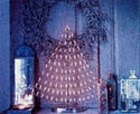26 July 2021
A Sign Of Summer: La rayure bretonne
19 July 2021
"Voce et intellecto" Barbara Hoogeweegen
12 July 2021
The Blue Lantern Turns Fourteen
I would like to thank very much the people who have devoted Pinterest boards to images published on The Blue Lantern. To celebrate the 14th anniversary of The Blue Lantern I decided to share some comments that warmed my heart and kept me writing
.
Wednesday, 15 July 2009 - The Edinburgh Scotsman
Subtitles "Arts Journalism for the Love of It," this devastatingly beautiful blog covers a wide range of topics and mediums from known artists such as Marc Chagall, to unknown discoveries, (well, unknown to us) such as Kathleen Dustin who makes exquisite handbags in the shapes of seed pods from a special type of colored polymer clay. The site is named for the blue-shaded lamp that French writer Colette used as a guiding light for her imaginary journeys, after she became too frail to leave home. "Her invitation, extended to all, was 'Regarde!' Look, see, wonder, accept, live." It is written by Jane Librizzi, an American broadcaster blessed with great intelligence and an eye for the rare and marvellous."
Sunday 22 August 2010 - The Linosaurus
Friday 16 September 2011 - Wuthering Expectations
...www.wutheringexpectations.blogspot.com
Wednesday 11 Janaury 2012 at Just A False Alarm
The Human Flower Project, Julie Ardrey, editor, Austin, TX.
Dear Jane - The Blue Lantern is a masterpiece. I have been a dazzled reader for awhile and am preparing to wind down my own site, The Human Flower Project. Having attempted to make something beautiful and thoughtful online, I deeply admire the ambition and generosity of your work! - Julie Ardrey
2009, The Curated Object, Joanne Molina, editor, Chicago
It's my absolute delight to introduce Jane Librizzi to our readers, Her intellectually stimulating and aesthetically astute blog, The Blue Lantern, has captivated me for more long mornings, afternoons, and evenings than I would care to admit. Originally from northern New Jersey, she lived in Newburyport, Massachusetts, and now lives in upstate New York. She studied piano for several years and began writing stories at age nine. Aside from freelance writing, she has worked in music broadcasting on her local Public Broadcasting station for the past nine years. The place in the world she woud most like to visit is the Wolong Panda Center in China.
04 July 2021
The Immigrants: Theresa Bernstein
One of the ideas running like Javascript behind this blog is that the history of the arts is more than a reductive mythology of large personalities. Like the writer who pens one or two good books but gets overshadowed by the colorful character who attracts academic acolytes, there are artists who produce a handful of memorable images but not enough to launch ancillary careers. Theresa Bernstein is one (1890-2002) despite a very long career.
Bernstein was known for her portrayals of the bustling crowds of New York City. The Immigrants is something quite different, a maritime picture of a kind, people huddled together on an ocean-going ship, waiting hopefully for the sight of land. They are heroic in a way we are not accustomed to think of as heroic, voyagers into an uncertain future. Anchoring the picture at center front is a young woman holding a baby; around her head an envelope of air that draws the viewer to the tiered decks receding behind her. A deft way to suggest the depth of space with sparse shadowing.
Before she painted The Immgrants, Bernstein's work was exhibited alongside that of Edward Hopper. Bernstein pretended that she had been born in America but her compassion for the trials of her fellow immigrants shines clearly in The Immigrants (1923). The group stands on the deck of the Cunard R.M.S. Aquitania. Although the immigrations numbers were falling during the 1920s, nativism was rising and Congress passed two laws to restrict immigration and set ne birthplace quotas.
Born in Kracow in 1890, Theresa Bernstein was brought to the United States by her parents and raised in Philadelphia. The Bernsteins were a well-educated., cultured family. When the Bernstein family moved to New York City in 1912, Theresa established a studio of her own near Bryant Park. She enrolled at the Arts Students League where she studied with William Merritt Chase and attended the earthshaking Armory Show in 1913 where ordinary Americans were introduced to all manner of non-representational painting. Bernstein had already been impressed by the works of Manet, Cezanne, Matisse, and Picasso on two trips to Europe in 1905 and again in 1911. Bernstein continued to produce art during every decade of her life, dying in 2002 at the age of one hundred eleven.
Image: Theresa Bernstein - The Immigrants 1923, oil on canvas, private collection.




